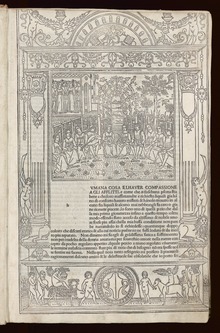 Illustration from a ca. 1492 edition of Il Decameron published in Venice | |
| Author | Giovanni Boccaccio |
|---|---|
| Original title | Decamerone |
| Translator |
|
| Language | Italian (Florentine) |
| Genre | Frame story, short story |
| Publisher | Filippo and Bernardo Giunti |
| Publication place | Italy |
Published in English | 1620 |
| OCLC | 58887280 |
| 853.1 | |
| LC Class | PQ4267 |
The Decameron (/dɪˈkæmərən/; Italian: Decameron [deˈkaːmeron, dekameˈrɔn, -ˈron] or Decamerone [dekameˈroːne]), subtitled Prince Galehaut (Old Italian: Prencipe Galeotto [ˈprentʃipe ɡaleˈɔtto, ˈprɛn-]) and sometimes nicknamed l'Umana commedia ("the Human comedy", as it was Boccaccio that dubbed Dante Alighieri's Comedy "Divine"), is a collection of short stories by the 14th-century Italian author Giovanni Boccaccio (1313–1375). The book is structured as a frame story containing 100 tales told by a group of seven young women and three young men; they shelter in a secluded villa just outside Florence in order to escape the Black Death, which was afflicting the city. Boccaccio probably conceived of the Decameron after the epidemic of 1348, and completed it by 1353. The various tales of love in The Decameron range from the erotic to the tragic. Tales of wit, practical jokes, and life lessons contribute to the mosaic. In addition to its literary value and widespread influence (for example on Chaucer's Canterbury Tales), it provides a document of life at the time. Written in the vernacular of the Florentine language, it is considered a masterpiece of early Italian prose.[1]
- ^ "Giovanni Boccaccio: The Decameron.". Encyclopædia Britannica. Retrieved 18 December 2013.